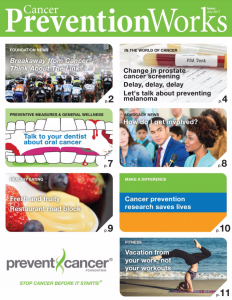
August 11, 2017
THANK YOU for coming together to call, write and visit your senators to send a clear message that cancer prevention is critically important and should remain a focus in the ongoing health care debate.
Because of YOU, the Prevention and Public Health Fund remains in place, and millions nationwide can still access lifesaving screening and early detection services to Stop Cancer Before It Starts!® While this was a clear victory for prevention, there is still much work to be done—and your voice is a crucial part of the conversation.
Food and Drug Administration (FDA) to reduce nicotine levels in cigarettes

This is the first time in the FDA’s history it has sought to regulate the amount of nicotine in cigarettes. The plan is part of a broader, multi-year effort to lay a scientific framework that helps the FDA better regulate cigarettes and other tobacco products.
“The overwhelming amount of death and disease attributable to tobacco is caused by addiction to cigarettes—the only legal consumer product that, when used as intended, will kill half of all long-term users,” said FDA Commissioner Jeff Gottlieb. “Unless we change course, 5.6 million young people alive today will die prematurely later in life from tobacco use.
The FDA will be accepting comments about lowering nicotine levels in combustible cigarettes to non-addictive levels through achievable product standards. We will notify you when the comment period is announced.
Read the Prevent Cancer Foundation’s full statement on the FDA’s plan.
Contact your member during August recess
Your members of Congress are back in their districts for August recess, providing a great opportunity for you to contact them. You can call their offices to set up a meeting to speak with your member, or their staff, on legislation you care about.
Here are some tips for an effective meeting:
SCHEDULE a meeting. Use our tool to find your elected officials’ office information. Every office has a preferred method of communication—typically this will be either phone or email. Call your elected official’s office and ask to speak to the scheduler to submit a request for a meeting.
PREPARE for your meeting. Pick two to three clear, easy to understand talking points. This will help narrow your message and make it easier for your member or their staffers to understand. It’s also helpful to know your elected official’s voting record on the issue—both for and against the issue you are addressing. You can typically find this information on their website.
FOLLOW UP after the meeting. Send a thank you email as soon as possible and include any additional information you promised to send.
Your voice is important! As a constituent, officials look to you for your thoughts and opinions when making a decision, so make sure you share everything you want them to consider. For more information and tips to help you become a more powerful and effective advocate, check out our Advocacy Toolkit here.

The summer edition of Cancer PreventionWorks is here to give you the latest news in cancer prevention and early detection. You’ll read about the following articles and more:
- The U.S. Preventive Services Task Force’s (USPSTF) new draft recommendations on prostate cancer screening and the importance of talking to your health care professional about PSA testing.
- Top tips for preventing melanoma or detecting it early from Dr. Sandra Lee, aka Dr. Pimple Popper.
- Advice about how to talk to your dentist about oral cancer.
Click here to read the summer newsletter and join our mailing list to receive all future editions straight to your inbox.


